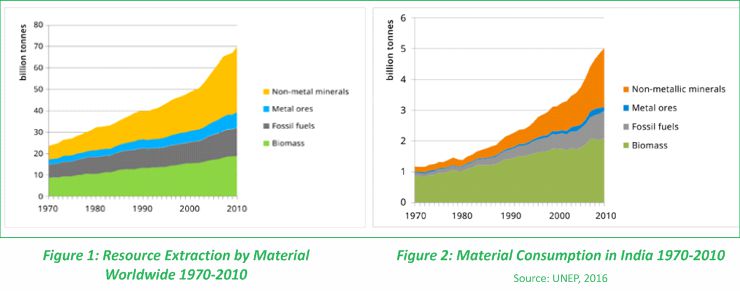Resource Efficiency
Today,
55% of the world’s population lives in urban areas, a proportion which is
expected to increase to 68% by 2050. India has the second largest
population in the world and 32% of the total population or about 380 million
people live in cities (Census 2011). With the increased population and
density, there is considerable pressure on natural resources. Increasing
economic activity and improper production techniques cumulated with
inconsiderate human behaviour with respect to waste disposal practices have
resulted in our cities being dotted with waste. These unsustainable levels
of resource use and waste generation have resulted in humanity exceeding
four of the nine planetary boundaries bringing much of the global life
support systems to critical levels. This has raised a hue and cry across
national and international communities with the UN and other member states
calling for urgent action through the Climate Accord, CBD commitments and
the SDG framework to address these concerns. The focal point of necessary
action i.e. the cities undoubtedly deal with issues of governance, carbon
intensity, population increase and influx which translates into overall
well-being of its citizens, which needs to be addressed both now and in the
future. Resource efficiency, circular economy and blue/green economy
perspectives are some of the related strategies that have been proposed to
address these complex issues (Turok I, McGranahan G. 2013).
Extraction of natural resources has been growing remarkably over the last several decades. The extraction of primary materials increased by a factor of three from 24 billion tonnes in 1970 to 70 billion tonnes in 2010 (UNEP, 2016). Figure 1 illustrates that extraction of both biomass and fossil fuels has doubled, while extraction of metal ores has tripled and the extraction of non-metal minerals has nearly quadrupled during the period.
In India, the material consumption of resources has leapfrogged by six times, from 1.18 billion tonnes (BT) in 1970 to 7 BT in 2015. This has important linkages to environmental impacts across the board including resource depletion, air pollution, changes in ecosystems and human health, biodiversity loss and climate change. The trend though indicative of the rapid economic growth, is also suggestive of the cost to the natural environment. Figure 2 is indicative of the same.
Piece-meal efforts by the Indian government so far has not necessarily resulted in achieving a balanced trade-off between growth, resource constraints and environmental well-being. Most of the policy interventions till now have focused more on end-of-life stage and that too on recycling. The other stages such as extraction, manufacturing and usage have not been given due importance.

The resource efficiency strategy by Niti Aayog first drafted in the year 2017 has been revised further to include circular economy perspective in 2019. The other policies in this space include:
-
Solid Waste Management Rules 2000 refined further in 2016,
-
Strategy for Promoting Processing of C&D Waste and Utilisation of Recycled Products 2018
-
Strategy for Secondary Materials Management for promoting Resource Efficiency and Circular Economy in Electrical and Electronic Equipment Sector 2018,
-
Strategy on Resource Efficiency 2017 revised as the Resource Efficiency and Circular Economy strategy in 2019 and
-
Overarching legislation of National Resource Efficiency Policy (NREP), 2019
NREP is envisaged as the overarching policy in terms of providing an institutional framework to uptake the resource efficiency agenda and highlight the importance of collaboration and partnership among public and private stakeholders for effectively harnessing resources through efficient use. However, there exists certain gaps and loopholes in the existing draft policy which garners attention.
Gaps in Draft National Resource Efficiency Policy (NREP), 2019:
-
There exists lack of clarity in the existing institutional set up of NREP, indicating which of the Indian functionaries i.e. ministries and departments will be included in it.
-
There is also lack of clarity in terms of achieving the targets which is stated to complement the SDGs till 2030 and further include targets on environmental restoration and resource efficiency post 2030. It is unclear as to what is the basic assumption here: Is it that we would have achieved ‘development’ for all by then as ‘sustainability of development’ which is critically dependent on restored health of eco-systems would not have been achieved till 2030 and hence will be taken care of post 2030 or restoration may not be under the purview of this policy but will complement eco-system restoration under the various climate commitments that India has made.
-
This apart, there is also no mention of the role of financial institutions and investors and the way in which the investor community will provide support and promote the resource efficiency and circular economy models.
-
The role of the government, especially the state governments to impart training and build capacities of the various stakeholders also lacks mention. More so, the modus operandi of the state governments to uphold the agenda of resource efficiency and integrate this into their state level policies lacks clarity.
-
There are also certain definitional inadequacies in the existing draft. For eg, the mention of the phrase ‘sustainable levels’ for every resource needs to be defined if this as a key aspect needs to be tracked.
-
Moreover, creation of ‘value’ with less material through resource efficient and circular approaches has to be elaborated upon. This essentially requires broadening the scope of ‘value’ to include ecological value of resources besides the potential value of physical or manufactured capital that can be created using the available resources.
-
The policy should ideally aim for a zero-waste production and consumption system rather than minimising it as ‘waste is a resource’ in the wrong place.
It is anticipated that addressing these concerns in the NREP, 2019 will indeed pave the way for an all-encompassing resource efficient strategy for India. ■
Reference
-
Turok, I. and McGranahan, G. (2013). Urbanisation and Economic Growth: the arguments and evidence for Africa and Asia. Environment and Urbanisation. https://doi.org/10.1177/0956247813490908
-
https://www.un.org/development/desa/en/news/ population/2018-revision-of-world-urbanization-prospects.html
Ria Sinha
rsinha@devalt.org